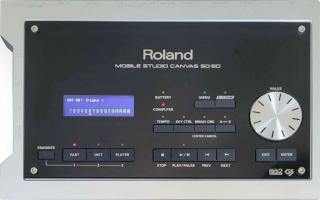Roland SD-50
 |
|
| W × H × D (mm) | 249.9 × 166.9 × 55.15[1] |
|---|---|
| Weight | 0.8kg[1] |
| Type | Desktop sound module |
| Manufacturer | Roland |
| Release date | 2010 |
| Standards | General MIDI General MIDI 2 Roland GS |
| Parts | 16[1] |
| Max polyphony | 128[1] |
| Normal presets | 1,125[1] |
| Drum presets | 32[1] |
| Effects | Reverb, Chorus, Mastering[1] |
| Output resolution | 44.1Khz/16 or 24 bits[1] |
The Roland SD-50 is a sound module released in 2010 by Roland. It is the final desktop MIDI sound module released by Roland in the vein of products like the Sound Canvas and Studio Canvas series.
Similarly to the SonicCell from 3 years prior, it's a desktop form factor module with a similar interface and comparably small 122 x 32 dot LCD display. Featuring a built-in USB Audio Interface, it can also output audio from a pair of analog RCA outputs. For inputs, it has a mono "1/4 input for a guitar and an XLR input, as well as a "1/8 stereo line in.
Despite the use of the Studio Canvas name, it has no relation to the original SD series from 2001. A lot of its PCM tones are featured on the Roland INTEGRA-7 as an expansion called ExPCM:HQ GM2+HQ PCM Sounds.
While having a conventional 9V DC input, the SD-50 also is USB bus powered. The top rear of the unit has a 3 way switch, the middle being "off", the left being to use USB to power the unit, and right being to use DC in/batteries to power it. You can only use Alkaline or Nickel-metal hydride (Ni-MH) batteries, and you must select on the unit (in Menu -> Battery) which type you have installed. The battery indicator on the unit will flash if the battery is low. [1]
Solo Tones
The Roland SD-50 features 3 "solo tones" that have special detail and don't use the traditional Roland-style PCM synthesis engine as the rest of the sounds on the unit.
Sporting articulations (staccato, glissando) and playing styles (like legato, growls) accessible over CCs, proper dynamic changes through velocity and programmed sound details to imitate the acoustics of the instrument. If this sounds familiar, it's because they are seemingly SuperNATURAL tones that can be found on units like the Roland INTEGRA-7.
For more details about how to control SuperNATURAL tones, please consult that article.